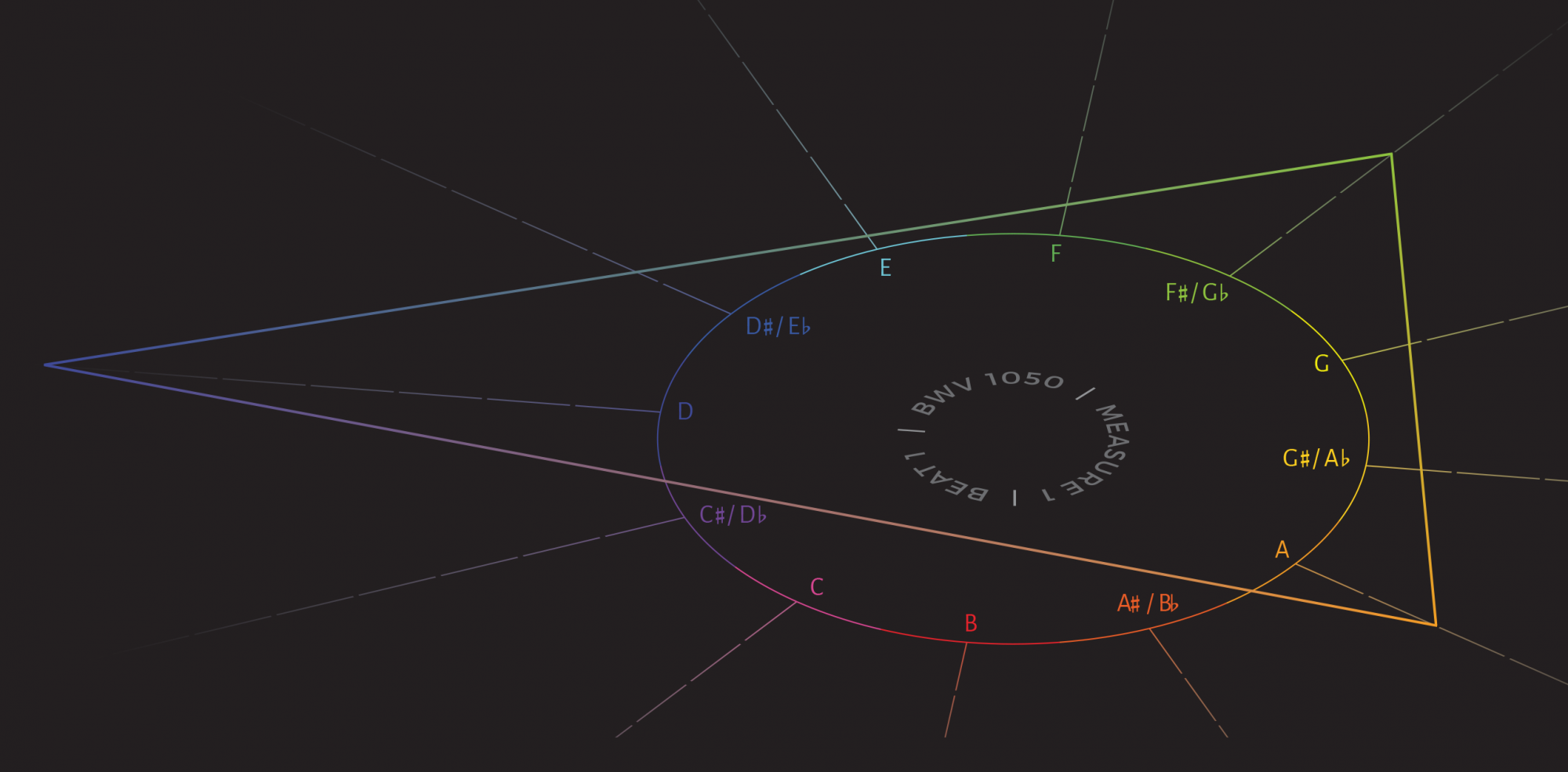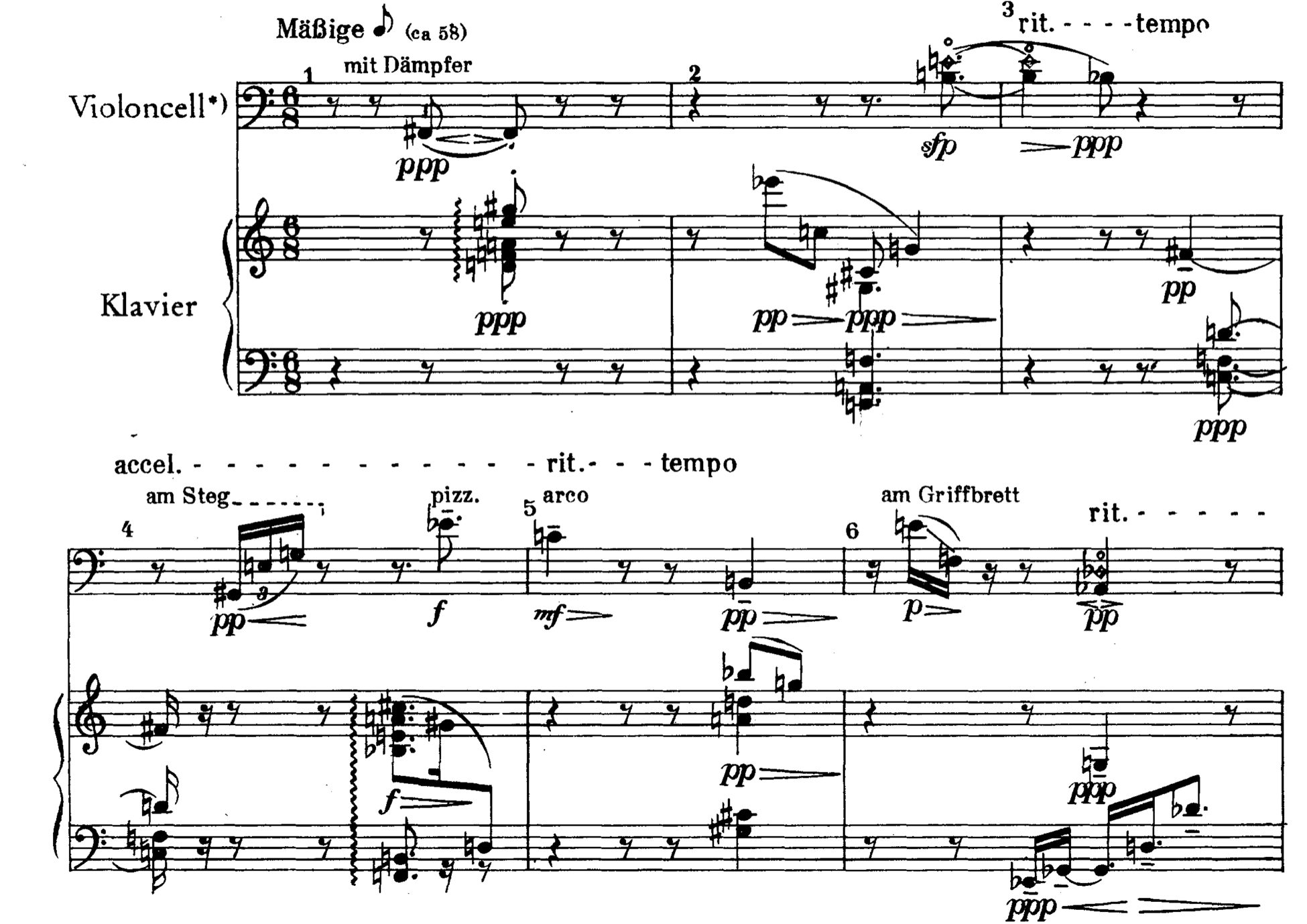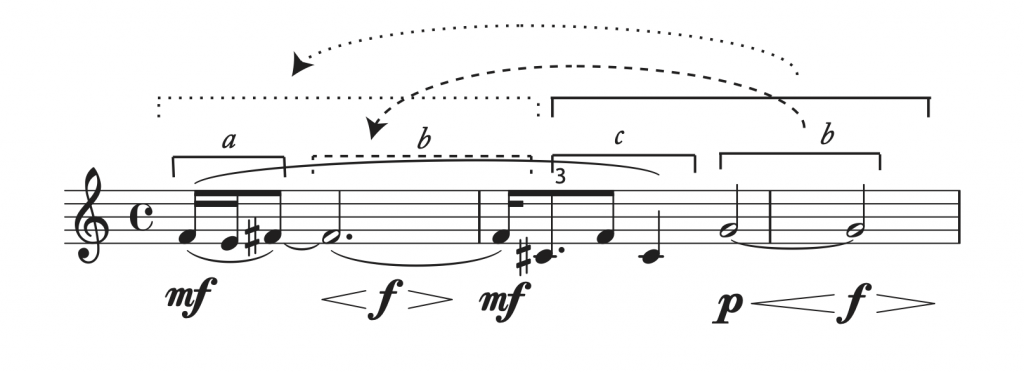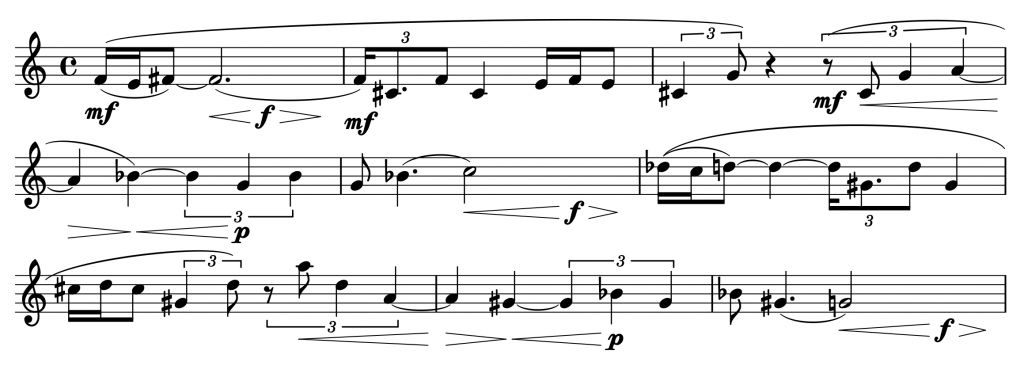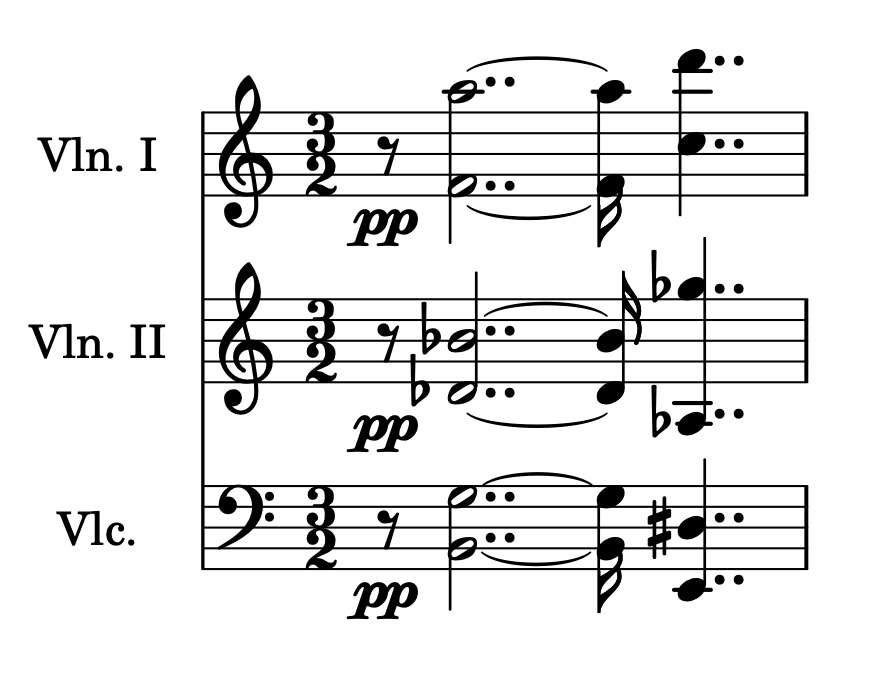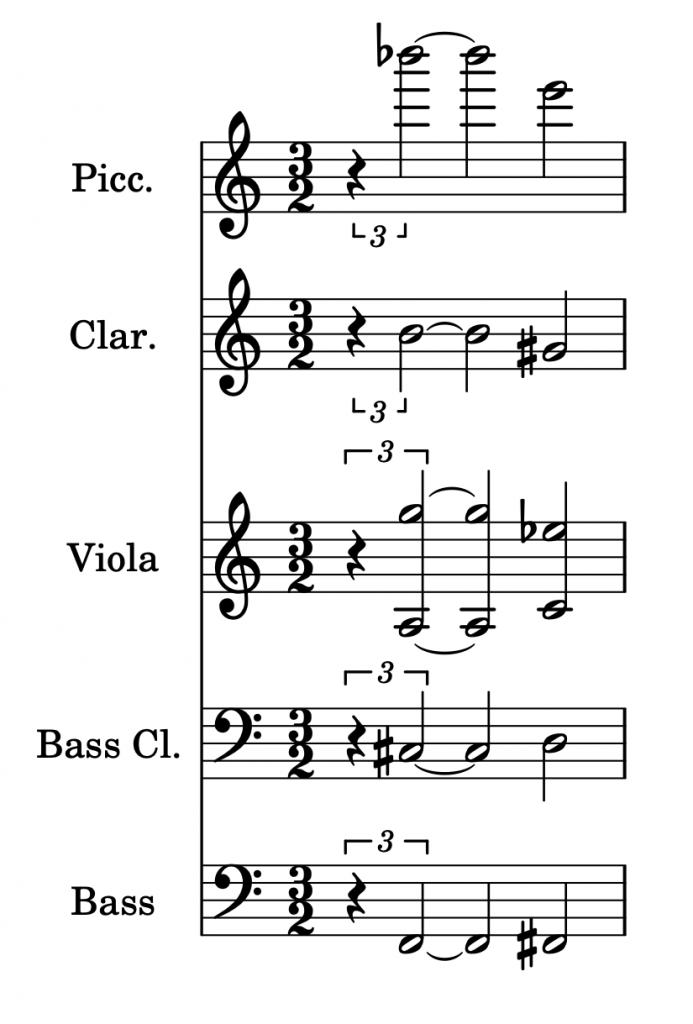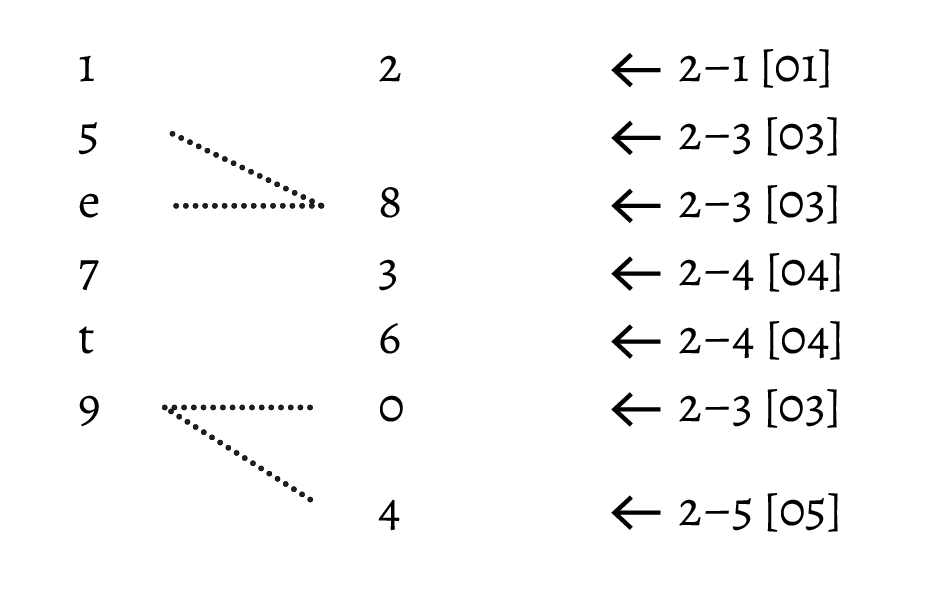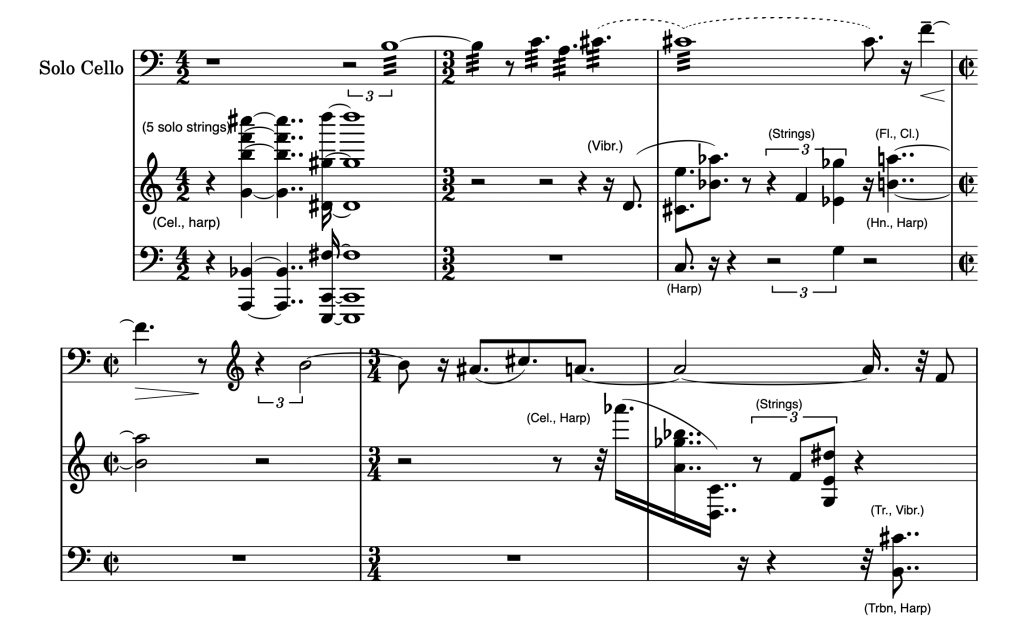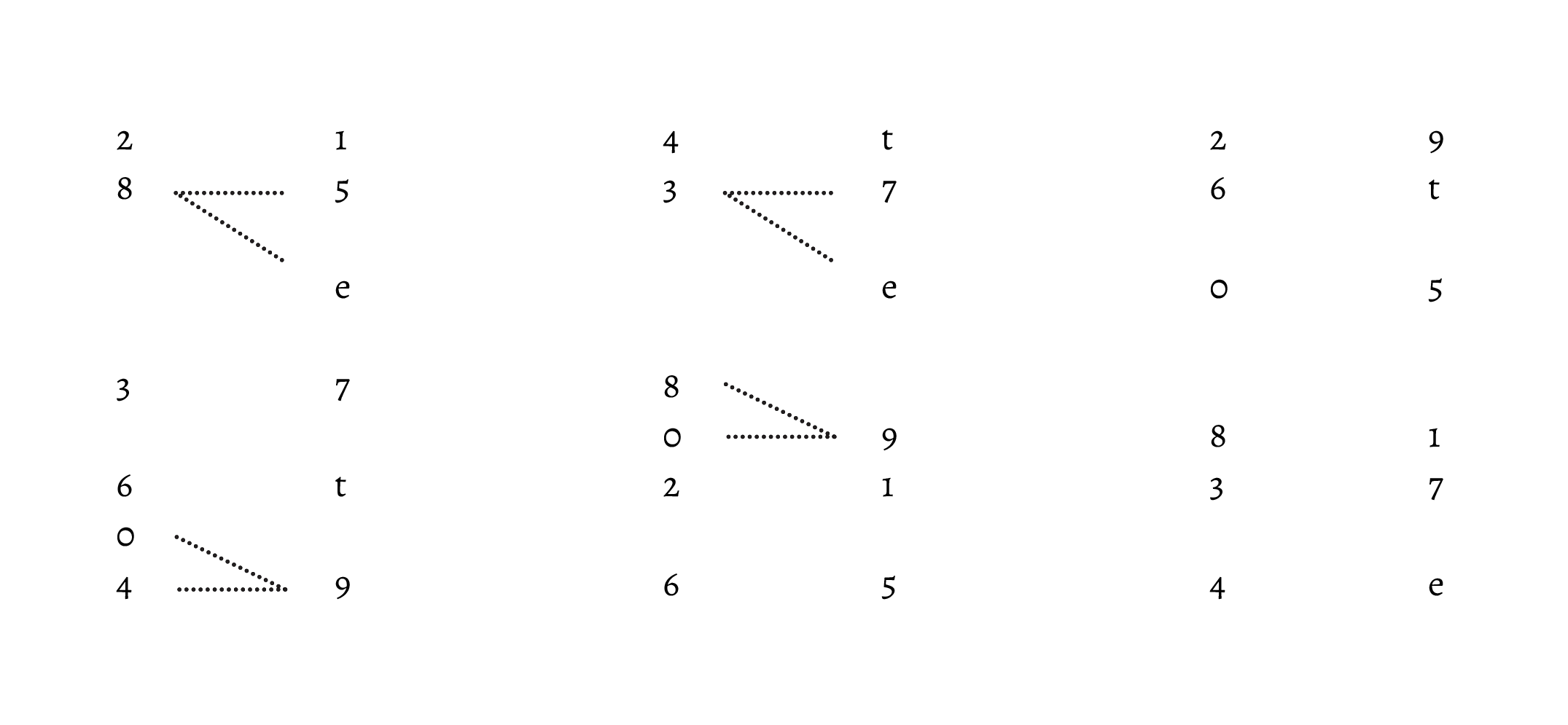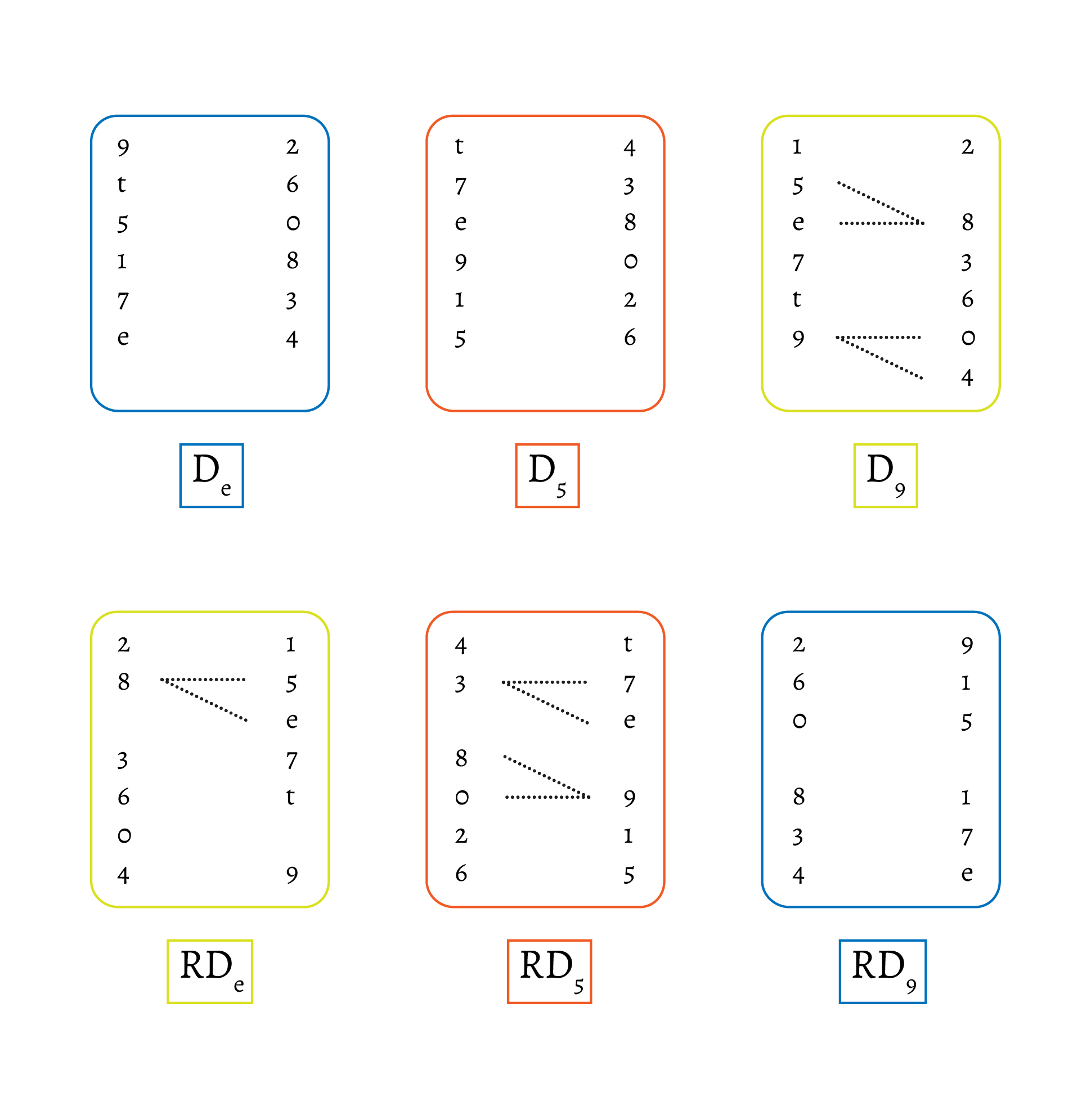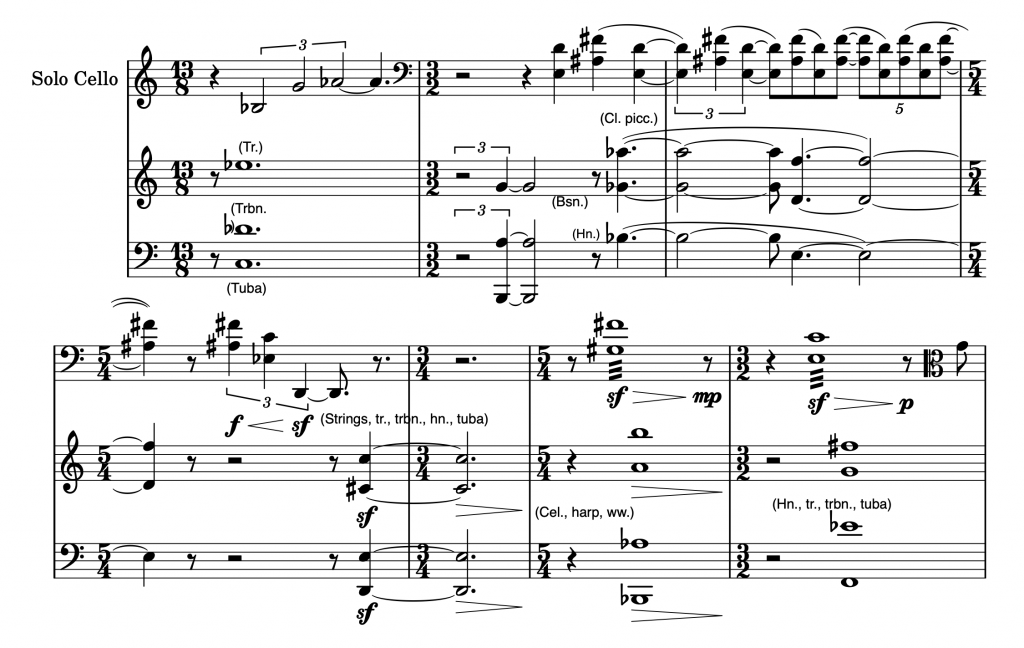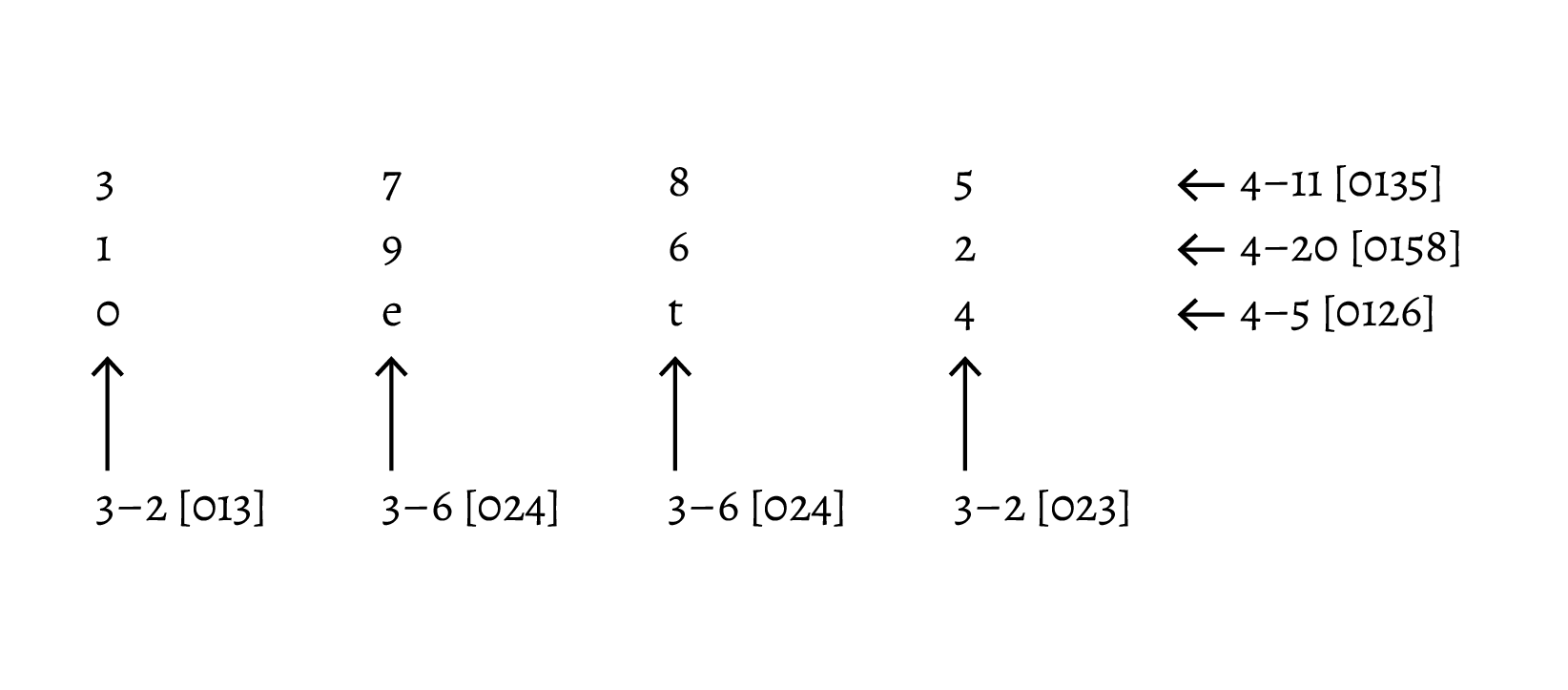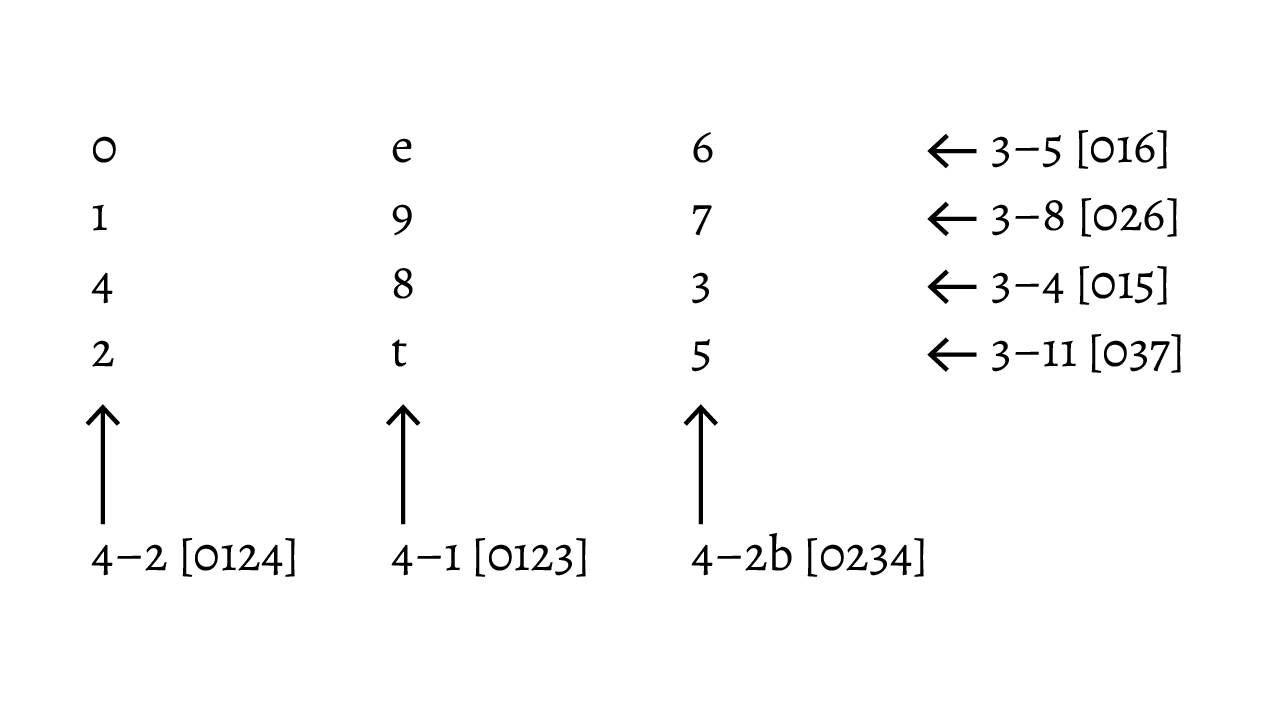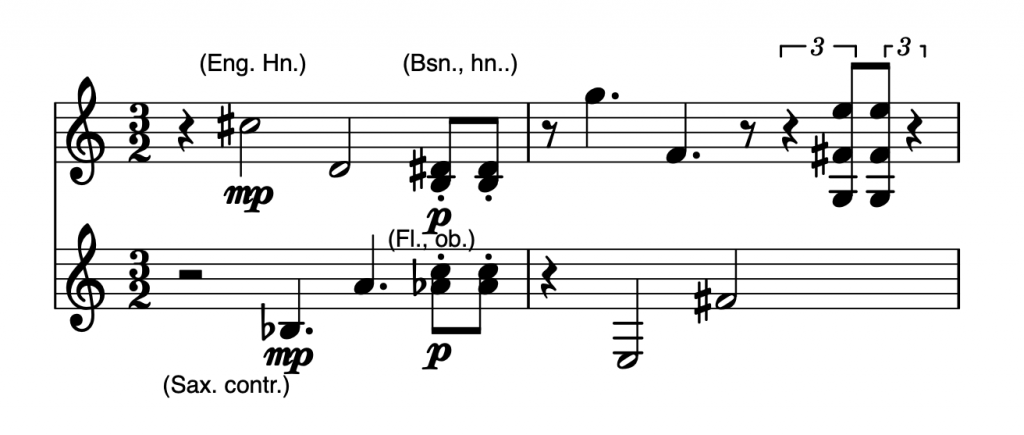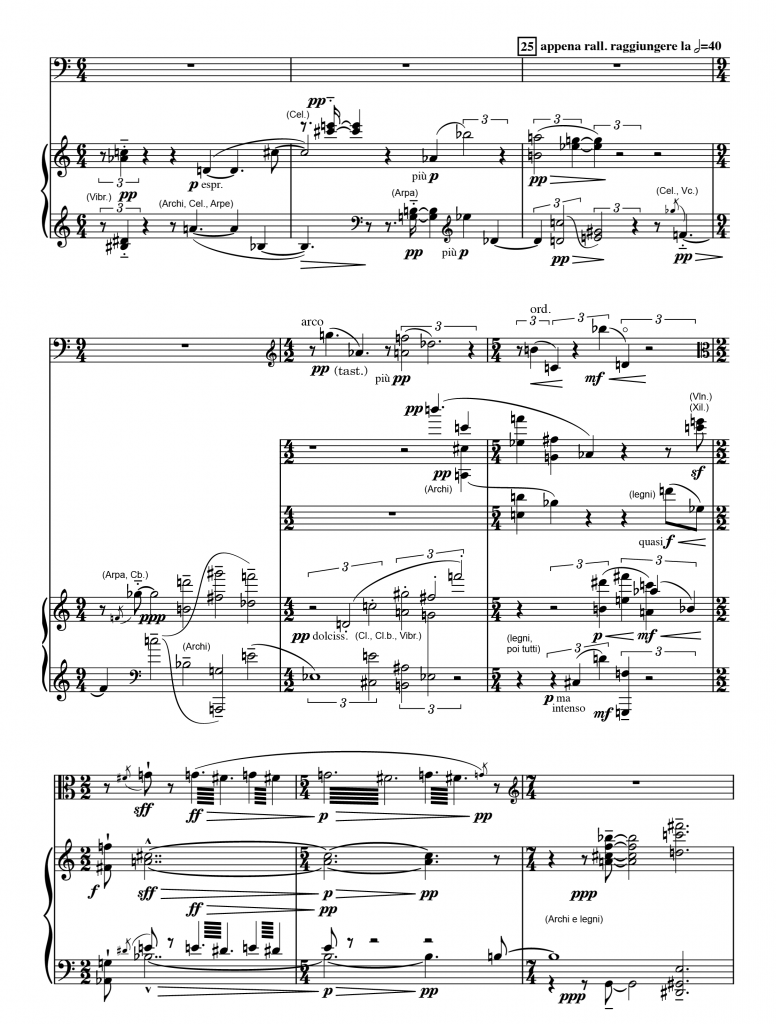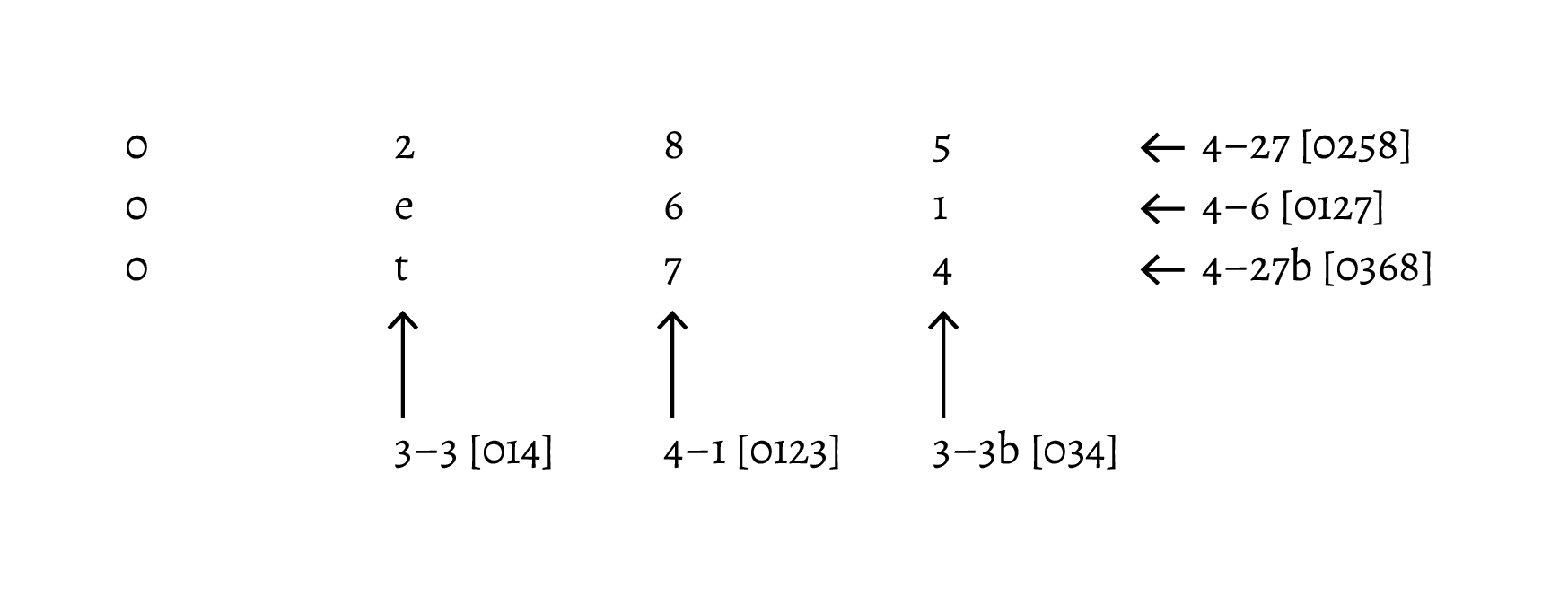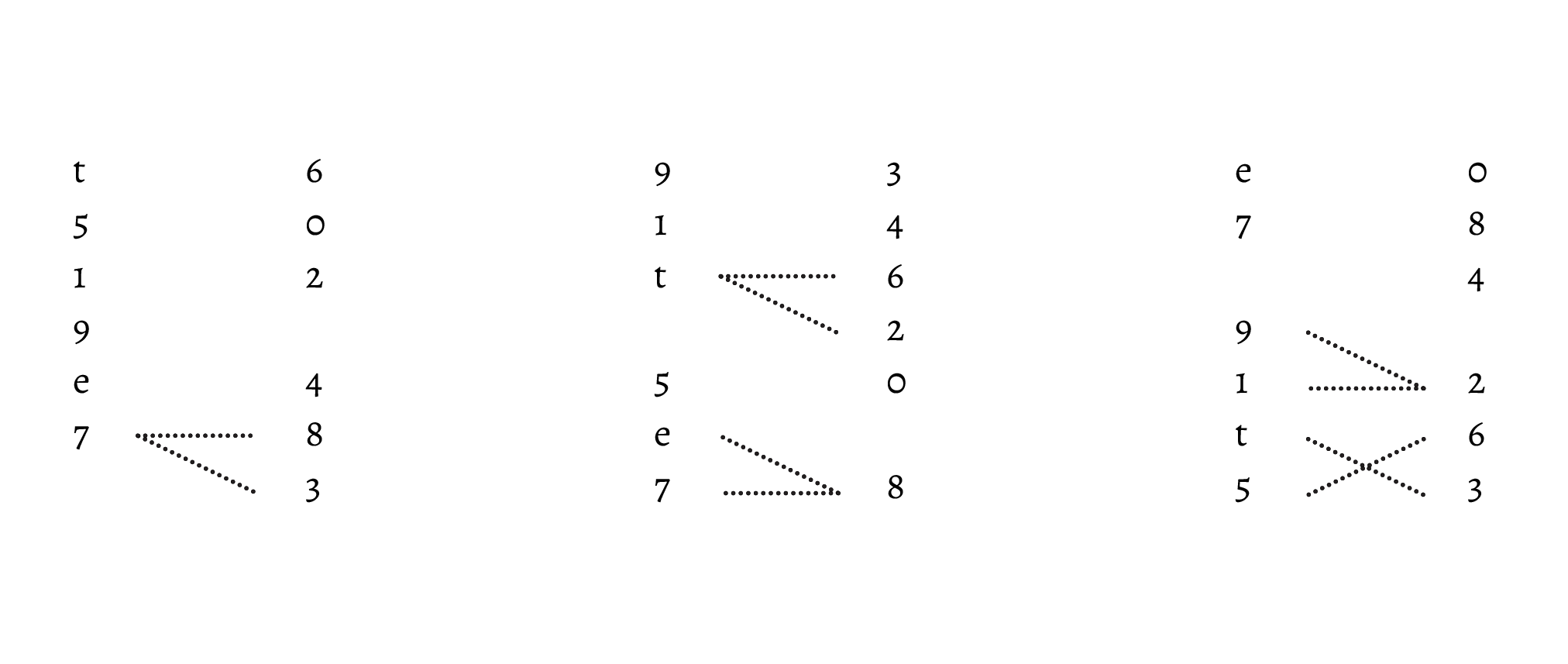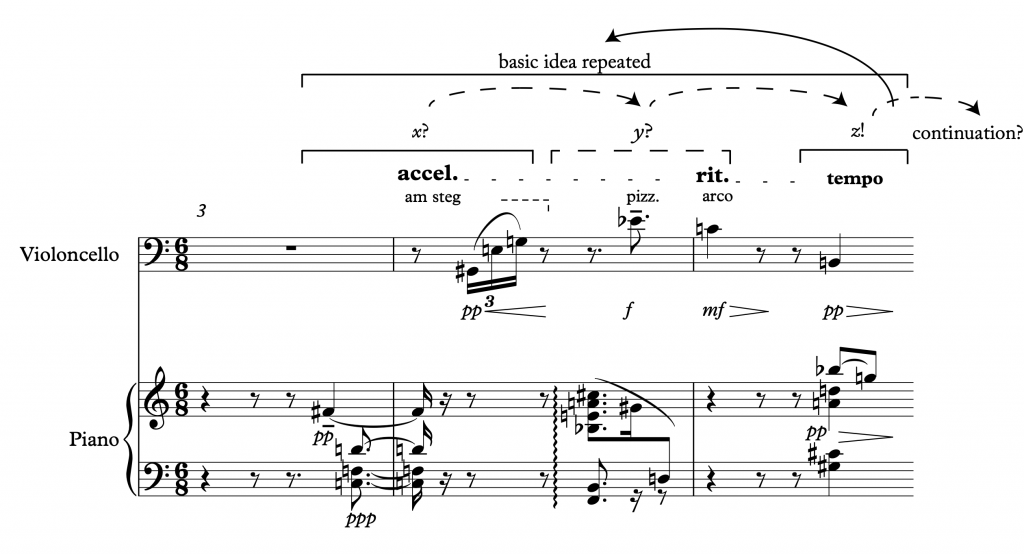Anabel Maler
Abstract
This article adapts Classical notions of formal function for the purpose of proposing a listener-centered theory of phrase formation in post-tonal repertoires. It contends that formal function is an emergent property of music through which a listener actively shapes musical organization in time. The result of this approach is a view of musical form in which the listener and composer mutually construct the significant formal units of a musical work through their interactions, a perspective particularly well adapted to the challenges presented by post-tonal music. In order to show how phrase structure in post-tonal music emerges through these formal affordances, the article analyzes in detail several passages from Edgard Varèse’s Density 21.5, Luigi Dallapiccola’s Dialoghi, and Anton Webern’s Three Little Pieces Op. 11, No. 1. The theory of phrase presented here encourages an understanding of phrase as fundamentally relational and constantly mutable.
Keywords and phrases: Form; post-tonal; formal function; phrase; listener-centered
Suggested CitationIntroduction
The concept of phrase looms large in theories of form and formal function. But despite its prevalence, “phrase” is an alarmingly slippery concept, reluctant to be tied to any particular length or content. This is especially true in the context of post-tonal music analysis, where the concept of phrase is frequently invoked but left under-defined. The meaning of phrase becomes especially attenuated when it meets with a non-tonal system of composition.
To illustrate, imagine that you are listening attentively, perhaps for the first time, to Webern’s Three Little Pieces for Cello and Piano Op. 11, No. 1, the opening measures of which are given in Example 1. First, the cello sounds a low F\sharp
I think it would be constructive to speak of these measures as comprising two phrases: in other words, as musical utterances that contain a coherent progression of events from beginning, to middle, to end, and that are articulated with something that separates each unit from those that may precede or follow it. This definition aligns with those provided by Hasty (1981, 1984) and Howland (2010, 2015), who define the post-tonal phrase as a coherent grouping of elements that is articulated from other groupings. But how does each of the three objects presented in the first phrase of Example 1 function in relation to the others? How would a listener make sense of these functions and relationships, in time, as they listen? Our current understanding of post-tonal phrase structure does not explain how each phrase comes to function in relation to the next, allowing the listener to form expectations and to retrospectively reinterpret the material they have already heard.
Building upon the perception-based and parametric approaches to post-tonal form proposed by Hasty (1981, 1984, 1988), Tenney (1988), and Howland (2010, 2015), as well as theories of formal function proposed by William Caplin, Janet Schmalfeldt, and Matthew Arndt, I take a form-functional approach to the post-tonal phrase that assumes that a wide variety of musical features—including rhythmic and melodic contour, pitch content, timbre, and texture—shape listeners’ categorization of musical objects and their formation of prospective and retrospective interpretations. In order to reformulate the idea of formal function for post-tonal repertoires, I conceive of formal functionality as a musical instantiation of what cognitive scientist Donald Norman has called affordances in his work on material design (2013). For Norman, affordances reflect the potential uses or actions latent in materials, and affordances are perceived not only based on physical attributes, but by the perceiver’s past experiences. Importantly, affordances are inherently relational—that is, they are determined in equal measure by the properties of the object and the abilities of the interacting subject. Affordances also rely on signifiers, which signal what actions are possible—these may be compared to what I have called salient parameters (Maler 2020). In a recent monograph, Caroline Levine applies this terminology to literary forms in order to demonstrate that “each shape or pattern, social or literary, lays claim to a limited range of potentialities”(2015, 6). So too does a formal pattern in music lay claim to a specific range of potentialities when it meets with a listener and all their beliefs and past experiences, and from that interaction we may come to determine its formal function.
In this article, I contend that formal function is an emergent property of music through which a listener actively shapes musical organization in time. The result of this approach is a view of musical form in which the listener and composer mutually construct formal units of a musical work through their interactions, a perspective particularly well adapted to the challenges presented by post-tonal music. In order to show how phrase structure in post-tonal music emerges through these formal affordances, I analyze in detail several passages from Edgard Varèse’s Density 21.5 and Luigi Dallapiccola’s Dialoghi. In adapting theories of formal function to the analysis of post-tonal form, this article contributes to the growing literature on post-tonal form and on formal function more broadly.1
1. Formal Function
The concept of formal function as it is presently understood has developed principally for the study of European music of the late eighteenth and early nineteenth centuries, a repertoire that has shaped the majority of music theory’s discourse. The idea that formal units play specific roles in articulating the structure of a piece of music is strongly tied to ideas about musical form that emerged through the teaching of composition in the early nineteenth century, and that was codified in the writings of Arnold Schoenberg (1967) and Erwin Ratz (1951), and more recently in those of William Caplin (1998, 2005, 2009). Caplin defines formal functionality as a concept in which “a listener is able to discern the formal disposition of events within a work by means of specific musical criteria, largely based on harmonic-tonal relations but also involving processes of grouping structure, melodic directionality and texture” (2005, 115). In an essay on the nature of formal functions, Caplin further distinguishes between formal functions and types (2009). He defines formal function as the “unique temporal character” of any given musical time span, while the notion of formal type refers to idiomatic phrase, theme, or movement types that comprise multiple functions, such as the sentence, period, small ternary, sonata, or concerto (33). In reference to Classical music, Caplin defines the form of a musical work as consisting of, at the least, a hierarchical arrangement of perceptible and discrete time spans, where each chunk of music has a formal function—a role that the group plays within the formal organization of the music (1998, 9). One of the most important characteristics of Caplin’s theory of formal functions is its implicit assertion that musical chunks or spans are fundamentally relational in nature—that is, a musical beginning, or middle, or end has no meaning outside of its relationship to the other two functions.
A given musical group may express more than one function or several groups may express a single function, and groups may be retrospectively reinterpreted as expressing a different function than initially suspected. Some of the foundational formal functions identified by Caplin include the basic idea, contrasting idea, presentation, continuation, antecedent, consequent, and framing functions such as introductions or post-cadential functions. Each of these is then defined in such a way that it can be correlated with other formal functions. In Caplin’s theory, then, the basic idea functions as a fundamental building block, usually comprising more than one motive in a single gesture. The presentation function emerges as the result of repeating a basic idea, through which the basic idea emerges as a distinct, demarcated unit. The presentation, Caplin argues, creates a “strongly ongoing quality” that generates demand for a phrase with continuation function. He identifies two characteristics of the function of continuation: “fragmentation, a reduction in the size of the units; and harmonic acceleration, an increase in the rate of harmonic change” (1998, 10). A contrasting idea presents opposing ideas, rather than offering a repetition of the basic idea. The presence of these two opposing forces, which brings about an intermediary cadence, forms an antecedent phrase, which prompts repetition in the form of a consequent.
Each formal function that Caplin identifies is shaped by one or more formal processes. These processes include fragmentation (reduction in the size of constituent units), harmonic acceleration (increase in the rate of harmonic change), extension and expansion (lengthening of units, extension by addition and expansion by an internal process), compression, and liquidation (gradual elimination of characteristic features).2
In his recent exploration of the relationship between form, function, and musical content, Matthew Arndt makes an important distinction between components, parts, and functions, arguing that “function” pertains to what the parts of a form are doing (2018). Building on Schoenberg’s theory of form, Arndt identifies eight structural functions, which overlap with Caplin’s formal functions and processes: establishment, confrontation, connection, dissolution, delimitation, elaboration, preparation, and stabilization. Establishment, or “putting something significant into place,” is often tied to a sense of beginning, and tends to be associated with tight-knit, stable, concise parts of music, while confrontation, or “encountering something different,” provides contrast and tends to involve the unconventional or unstable (212–213). Connection involves joining members by providing links that “mediate between previously contrasting parts;” these links might take the form of transitions or small bridges. Dissolution involves “letting go of characteristics,” either by harmonic destabilization or through liquidation, which may include “reduction (omission), equalization of rhythmic values and/or intervals, leveling off of contour, and using nondescript figures such as scales” (213). Delimitation serves to articulate parts from one another, while elaboration is “leading motives or Gestalten through new situations” and often has the effect of intensifying the material (214). Preparation, or “getting ready for a following member,” is closely related to Caplin’s idea of introductory function. Finally, the function of stabilization involves “making a harmony firm” (214).
Crucially, the formal function of a musical event or phrase may change over time as the listener reevaluates and reinterprets the musical material and context. Janet Schmalfeldt explores this nonlinear conception of musical form through her principle of “becoming:” “the special case whereby the formal function initially suggested by a musical idea, phrase, or section, invites retrospective reinterpretation within the larger formal context” (2011, 9). This approach opens the possibility that the relationship between form and time is not linear, which challenges the idea that formal units must be both temporally discrete and adjacent in order to form larger units.
One of my fundamental assumptions is that formal listening and understanding did not abruptly change or cease to exist in the early twentieth century. Indeed, in his discussion of the origins of his musical style, Anton Webern made it clear that he and the other members of the Second Viennese School based their compositions on prototypical Classical formal structures (Webern 1975). The Formenlehre tradition is intimately tied to music of the high Viennese classical style; that said, I suggest that listeners did not stop trying to make sense of musical form in terms of its organization into functional groups after a certain date, or in response to the opinions of any particular composer or critic in the early twentieth century. Accordingly, attentive listening to function, in the sense of musical affordance, is not tied exclusively to specific formal types. In fact, attending to these affordances in post-tonal works can have, I propose, a positive impact on our understanding of their formal organization.
In the course of analyzing post-tonal works, I therefore make use of terms that may be familiar from Classical formal theory. When I do so, it is not to point out some surface similarity between the formal group being presented and its counterpart in a Classical formal type, but to make an observation about the way that musical group is functioning in relation to surrounding musical materials—as Arndt puts it, what the music is doing (2018, 224). The core idea, then, is that the musical concepts implied by functional labels such as “basic idea” or “contrasting idea” remain relevant in post-tonal contexts.
2. The Post-Tonal Phrase
In the context of post-tonal form, Christopher Hasty defines the phrase as a perceptual necessity, within which “groupings of elements cohere to create a sense of wholeness or completeness,” and which is segregated from unrelated elements by means of closure (1984, 171). Patricia Howland’s concept of the “integrated parametric structure” (IPS) is based on Hasty’s definition of the post-tonal phrase as well as James Tenney’s post-tonal “sequence” (2015). Howland defines the phrase-like IPS as “a succession of elements in which the whole exhibits coherence and articulation” (71). Following from these definitions, the post-tonal phrase, as it were, seems to possess the following necessary features: it contains more than one item, it coheres together, and it is articulated from other groupings.
To speak of the post-tonal phrase, one must possess an underlying understanding of post-tonal compositional structures as: a) adhering to guiding principles of logic and coherence; b) possessing forms of punctuation akin to cadences in tonal music; and c) tied to the resources of a listener’s working memory. To employ the term “phrase” to describe a phenomenon in a post-tonal composition is therefore to acknowledge an underlying perceptual framework that has historically been investigated in the context of tonal compositional techniques. Like phrases in tonal music, phrases in post-tonal music need a coherent progression from beginning, to middle, to end—articulated with something that functions to cadence, or close. The question remains, how do listeners make sense of these units and their relationships to one another?
To summarize the perspectives of Hasty and Howland, a phrase in post-tonal music is a unit that contains more than one musical idea. Its constituent ideas must form a coherent whole, to which the listener is guided by musical parameters that gain particular salience within the context of the composition. The perception of salient parameters informs the formation of categories by establishing which attributes determine category membership; those categories then provide a structure for the processes of listener prospection and retrospection, which I clarify later.
Howland’s theory of the IPS explains how phrases can cohere even without structural closure in the form of a return, which Hasty sees as fundamental to coherence and closure in post-tonal phrases (Hasty 1984, 176, 178–179, 186). Instead, Howland argues that the audible grouping of parameters is in fact capable of “creating the degree of interrelatedness necessary to achieve coherence” (74). While some IPSs, like those based on tension/release, departure/return, and symmetry, are articulated through return, others are articulated through salience or replacement.
Many post-tonal works indicate phrase closure through processes of intensification and tension followed by resolution and release. Indeed, Barash (2002) has identified processes of intensification and resolution produced by multiple parameters—duration, silence, contour, centricity, activity level, motivic and phrase repetition, tempo, dynamics, texture and color, and articulation—as central to the concept of cadence in post-tonal repertoires.3 According to this understanding of closure in terms of tension and release, elsewhere, I define the cadence as “a conventional musical object that is recognized through norms involving motivic dissolution, repetition, pitch convergence or divergence, registral aspects, textural elements including density and contrast, rhythm, timbre, orchestration processes involving tension and abatement, and phrase structure” (Maler 2020). A full exploration of the concept of closure in post-tonal music goes beyond the scope of this article, but I will use these basic definitions to inform my analysis of closure at the phrase level in the analyses that follow.
The concept of formal functions such as establishment and confrontation draws on our shared cognitive strategy of attending to similarity and dissimilarity in making sense of music. James Tenney’s thesis Meta + Hodos presents an early exploration of this topic through the lens of gestalt psychology, arguing that differences create separation between elements, while similarities produce cohesion (Tenney 1988). Alexandra Lamont and Nicola Dibben provide an overview of two main models in cognitive psychology for understanding similarity and categorization (2001).4 The first, prototype theory, is based on perceptual equivalence, or the relationship between the object and an abstract prototype. The second, theory-based classification, emphasizes the role of background knowledge and conceptual models in categorization. Drawing on the latter model for categorization, Lawrence Zbikowski has developed a robust theory of how these conceptual models are applied in different musical contexts (2002). Dora Hanninen’s work also emphasizes the importance of “difference and disjunction” in sonic organization in both small segments and larger units, arguing that “greater differences in attribute values create greater disjunctions and stronger boundaries” (2012, 7).
The process of object categorization involves a listener’s active formation of categories from the collection of perceptual objects put forth by the composer. These objects cohere into categories that, according to Zbikowksi, reflect “the attributes shared by those [objects]” (2002, 49). Hanninen identifies object categorization as part of her “contextual domain,” which recognizes “repetition, association, and categorization in music” (2012, 7). Hanninen emphasizes importance of context in the contextual domain, arguing that musical objects are “permeable, suffused by and interacting with their contexts” (2012, 7). The process of object categorization as it relates to form might arise, for example, when an analyst identifies a musical object as separate from other objects and serving as a “cadential” marker. In the case of both Brian Fennelly’s and Christopher Hasty’s analyses of Webern’s Op. 22, the analysts make use of the salient parameter of rhythm in order to categorize some musical object as “cadential,” in contrast to surrounding units (Fennelly 1966; Hasty 1988). Hasty notes that, in addition to the salient parameter of rhythm, the repetition of the material at section boundaries marks this unit as belonging to a “cadential” category. At the same time, he notes that the figure also acts to begin a section through a process of elision; this observation draws upon my final factor for phrase analysis, prospection and retrospection.
The notion of phrase is intrinsically both prospective and retrospective, in that it requires the listener to predict its continuation and to retroactively group its units together. The phrase thus necessarily takes place within the present. Briefly summarized, the present—as conceptualized by Husserl’s 1901 model of time consciousness—is experienced as a continuously temporally unfolding span whose horizons are bookended by “retention” (referring to the ever-more distorted view we have of past events as the now moves inexorably forward), and “protention” (referring to our view of the immediate future).5 Akin to Husserl’s concepts of protention and retention, the musical phrase emerges through a process of listener prospection and retrospection. Based on the presence of salient parameters, musical context, and culturally engrained patterns, the element of prospection refers to the listener’s judgment of the presence of an emerging phrase in the present moment. The process of retrospection involves the deciphering of what has just occurred based on expectations met or denied. The processes of prospection and retrospection have to do with how listeners form expectations and react to events in musical time, a topic first explored in detail by Leonard Meyer (1956), who revealed how musical structures create perceptual expectations that can be manipulated by composers in order to communicate emotions. Importantly, Meyer argues that a musical style must “become part of the habit responses of composers, performers, and practiced listeners” in order to “be regarded as a complex system of probabilities,” out of which arise the expectations upon which meaning is based (1957, 414). A number of scholars have elaborated upon and tested Meyer’s theories of expectation and meaning, including several studies that reveal how musical expectations influence the perception of music (Cuddy and Lunney 1995; Krumhansl 1995; Schellenberg 1996; Schmuckler 1989).6
My development of these concepts in relation to post-tonal music—all of which contribute to formal function—emerges from a recent move towards basing analytical discussions within an understanding of cognitive processes shared among human listeners. Using the concept of formal function developed by Caplin, extended by Arndt, and bolstered by the important work on post-tonal phrase structure by Hasty, Howland, and others, I propose in this article a way of analyzing post-tonal phrases through the lens of formal function. In the following sections, I analyze some passages from Varèse’s Density 21.5 and Dallapiccola’s Dialoghi, with a focus on how a listener might make sense of the formal functions or affordances of musical materials, thus engendering musical expectations at the phrase level. Of course, the specific interpretations of formal functions reflect only my own hearing of these works—another listener-analyst might develop their own, conflicting interpretation of the very same passages. The purpose of these analyses is not to provide the only, or indeed the definitive, phrase-structural accounts of these works; instead, I hope to suggest one potential reading of these passages based on the concepts of phrase-level function outlined by Caplin and Arndt, revealing that form-functional concepts are applicable to repertoire far outside of the Classical period.
3. Varèse, Density 21.5, mm. 1–17
There is a long and rich history of analyzing Varèse’s Density 21.5 (composed for solo flute in 1936, revised 1946), and analysts have approached the work using a variety of theoretical frameworks and perspectives. Jean-Jacques Nattiez’s semiological analysis of Density 21.5 appeared in full, translated from the original French by Anna Berry, in the first volume of Music Analysis in 1982. Most of the publication is devoted to the analysis of the work’s “neutral” level, while the end of the article briefly addresses the “poietic” and “esthesic” levels.7 Nattiez partitions the work into units, from the smallest to the largest, dividing the work into 83 distinct units on the smallest level and into 3 parts on the largest. At a few places in his discussion, Nattiez suggests the idea of formal function. This first occurs early in the analysis in the discussion of the work’s first few measures, where Nattiez introduces his concept of “deception.” Nattiez does not seem to use the word as it is typically employed with respect to the “deceptive cadence,” or “cadence rompue” in Rameau’s terminology.8 Instead, by “deception,” Nattiez means that the events at the beginning of m. 2 function to delay the passage of F\sharp
Nattiez’s most explicit mention of function comes at the end of his analysis of the work’s second part, in which he identifies “three segmental types,” which have “three functions:”
the permutation is stagnant, delaying the appearance of a new note which is generally a semitone higher; or oblique paradigms allow the piece to progress; or rapid flights lead to a climax. Between them, these types set up a dialectic: the permutation acts as a brake on development—in relation to the oblique paradigms and the flights it favours a period of rest rather than moments of tension. Varèse restores, on another level, what the tonal system is no longer able to offer, by alternation of distinct functional types (Nattiez and Barry 1982, 283).
Nattiez’s “functions” in the context of Density 21.5 provide a glimpse into the potential advantages of approaching a piece like Density from the perspective of formal function, despite the absence of tonal idioms. In the following analysis of the first seventeen measures of Density, I draw more explicitly on the concept of formal function in order to analyze the work’s opening phrase structure in detail.
The first fifteen measures of Density are provided in Example 2. I would like to propose that in the first fourteen measures of the work, a sentential structure slowly emerges for the listener as they interact with the piece. In the analysis that follows, I reveal how the work’s first five measures act as a presentation, fulfilling Arndt’s establishment function, while mm. 6–12 employ the functions of confrontation and dissolution to create a sense of a continuation, followed finally by the delimitation function in mm. 13–14, which creates a sense of closure.
The opening of Density 21.5, shown in Example 3, features a three-note cell that groups together interval classes (ICs) 1 and 2, straining upwards from the lowest register of the flute (a). This first cell, and its continuation in the form of a dynamic swell on the sustained F\sharp
Imagine instead that the sustained G4 had not entered after motive c, and thus had not retrospectively prompted the listener to consider, at least provisionally, the presence of a single basic idea in mm. 1–3, one that contains three distinct motives a, b, and c. Example 4 conceives of a possible alternate ending for the first phrase, in which motive a is repeated (in an inverted form) after motive c.9 This recomposition of the first measures prompts an entirely different understanding of the formal functions at play, in which the repetition of motives a and c in a compressed and partially inverted form in mm. 2–3, immediately after their initial presentation in mm. 1–2, suggests that the listener reinterpret the first two measures as a basic idea that is immediately shortened and repeated (forming what Caplin might call a presentation phrase). Now the basic unit of the work is much shorter, since the first three measures no longer suggest a single, incomplete idea, but a complete opening presentation phrase containing two units. The listener may now have a different expectation for the material that follows: they may strongly predict that contrasting material will enter, material that moves the piece along and draws it further away from the familiar intervallic, rhythmic, and motivic space established in the first three measures. For the moment, however, let us return to Varèse’s original composition, and the material that follows the unaltered mm. 1–3.
In Varèse’s original composition, the quarter-note rest in m. 3 is immediately followed by the entrance of motive a, which begins a varied repetition of the basic idea, shown in Example 5. This varied repetition confirms the cohesiveness of the basic idea in mm. 1–3 by submitting the individual elements to the formal process of expansion. Motive a is subject to a linear expansion through its continued melodic ascent to G, and its contour returns in an inverted, expanded form at the end of m. 4. A repetition of the expanded motive c closes the variation on the basic idea as a whole.10 The varied repetition of the basic idea in mm. 3–5 results in a formal function of presentation over mm. 1–5, which may lead the listener to expect a continuation to follow.
In m. 6, the closing gesture of m. 5 is recast as a beginning (Example 6). The material that follows draws on motivic elements from the basic idea (a rising stepwise line), recontextualized within the octatonic scale. While the repetition of the basic idea hinted at the octatonic scale as a background collection in the descending portion (second half of m. 4–5), the music of m. 6 onward confirms it. The phrase also revisits and emphasizes IC 3 (introduced briefly between motives in m. 5) in the form of an oscillation between B\flat

The unit from mm. 6–8 achieves conditional delimitation through the repetition of motive b, which was already associated with internal divisions when it ended the basic idea, retrospectively allowing us to understand the basic idea as internally divided by motive b into two smaller units. Motive b now also divides this phrase into two smaller units: first an internal division in m. 7, with the dynamic arch-shape reversed (decrescendo-crescendo), followed by a more conclusive iteration at the end of m. 8, with the original dynamic marking of motive b restored.
We might briefly revisit my hypothetical recomposition of the first measures, in which the first three measures (a basic idea and its foreshortened repetition) are now promptly followed by material from the original mm. 6–8, fulfilling the listener’s expectation that the complete presentation of ideas in mm. 1–3 will be followed by material that develops these ideas in a continuational manner. The fully recomposed mm. 1–5 is shown in Example 7, comprising a much shorter presentation of materials than is found in the original. One notable feature of the recomposition is that I have kept mm. 3–5 nearly identical to the original mm. 6–8, only shortening the note value of the intermediary statement of motive b on B\flat
The material in the original mm. 6–12 spins out and elaborates the three motives a, b, and c in varying configurations, pushing ever higher in register through each varied repetition. In my view, this section takes on the function of a continuation phrase for the listener due to its use of elaboration techniques like fragmentation and repetition, speeding up of the surface rhythm, as well as elements of dissolution (liquidation) such as using nondescript figures, all of which increase the sense of tension or urgency in anticipation of closure. This continuation spans three units that decrease in length: the first from mm. 6–8, which emphasizes the octatonic collection and contracts motive c, the second from mm. 9–11, and the third from the end of m. 11 through m. 12 (the section from mm. 9–12 is shown in Example 9).
As shown in Example 10, mm. 13–14 combine several features previously associated with closure (a long held note, dynamic swell, and emphasis on IC 6) with the octatonic collection, providing a summary of the preceding material in a single, concise gesture, while also continuing the spatial expansion brought about by mm. 11–12. The next measures repeat and confirm this closure, using only ICs 1 and 2 and recalling both the motivic material and phrase structure of the opening basic idea. By repeating the functions of summary and closure—alluded to by Nattiez in his use of the phrase “rounding off and summing up” in reference to these measures (Nattiez and Barry 1982, 265)—and by echoing the contour of the material in mm. 13–14, Varèse confirms in mm. 15–17 that a point of structural articulation has been reached, and encourages the listener to anticipate the establishment of new or contrasting material.
In the preceding analysis, the form of the first, quasi-sentential phrase of Density 21.5 emerges as a series of negotiations between composer and listener. The composer’s choice of pitch collection influences the listener’s perception of similarity and contrast, but the listener’s understanding of function and grouping impact how the work coheres. The analysis reveals a process by which musical elements interact—combine, coexist, push against one another, accumulate, disintegrate, and negate—to produce larger phrases. The following analysis of Dallapiccola’s Dialoghi shows how these phrases may further interact to form larger formal structures.
4. Dallapiccola, Dialoghi (1959–1960), first movement
In Dallapiccola’s Dialoghi for cello and orchestra, the composer inextricably ties phrase structure to a particular serial technique: cross-partitioning. Gaining an understanding of the particular configurations of cross-partitions in this work is inherently valuable from the perspective of twelve-tone analysis, but an approach that views those cross-partitions through the lens of formal function is important to develop an understanding of the work’s most striking features: its clarity of phrasing, the melodious quality of the cello line, and the unique framework of interactions between the cello and orchestra. Analyzing the phrase structure of Dialoghi’s first movement alongside and through its twelve-tone innovations can provide insights into the composer’s choice of this particular style of cross-partitioning, as well as its effects on a listener. Moreover, a clear and detailed analysis of phrase structure appears essential for understanding the dramatic arc of the first movement, which is firmly tied to the work’s first phrase: three measures of cross-partitions in the orchestra, cohering into one, arch-shaped unit. As I show through my analysis, the structure and sequence of musical events on the level of the phrase contribute to a larger-scale formal process of loosening in the first movement’s A section, summarized in the formal graph of Figure 1.

Dialoghi is based on the twelve-tone row < 0, 1, T, 2, 6, 4; 5, 3, 7, E, 8, 9 >.11 The row is inversionally combinatorial and, as Brian Alegant observes, RI-symmetrical—that is, its Po and I9 forms are retrogrades of each other:
P0: < 0, 1, T, 2, 6, 4; 5, 3, 7, E, 8, 9>
I9: < 9, 8, E, 7, 3, 5; 4, 6, 2, T, 1, 0>12
Dallapiccola often obscures the row form in Dialoghi through the technique of cross-partitioning, which has been discussed thoroughly by Brian Alegant (2001). In a cross-partition, a twelve-tone row is partitioned in order to create vertical harmonies. A twelve-tone row may be divided into equal partitions of 2 groups of 6, 6 groups of 2, 3 groups of 4, or 4 groups of 3. Analysts often represent cross-partitions through a table that sets out the subsets, resulting in a “two-dimensional configuration of pitch classes whose columns are realized as chords, and whose rows are differentiated from one another by registral, timbral or other means” (Alegant 2001, 1). The pitches in the resulting vertical combinations may be reordered in order to maintain the vertical harmony while altering the horizontal melodies.
Figure 2a shows the first cross-partition of Dialoghi, DE, which is based on the unordered hexachords of R2: <E, T, 1, 9, 5, 7; 6, 8, 4, 0, 3, 2>. Where the uppercase “D” represents the name of the piece, Dialoghi, the subscript “E” in DE represents the lowest pitch class of the first chord. The first column of the cross-partition is the first collection played in the piece, and is sounded pianissimo by the violins and cellos. The second column represents the second sonority, played by the same instruments. Each column contains one unordered hexachord of the row form R2. One thing we can note about this first cross-partition is that the pitches A, F, D\flat

Figure 2b reveals what Alegant terms a “slot-machine” transformation of DE in which new intervals are introduced: the semitone, the minor third, and the tritone. This new ordering of the cross-partition, D5, appears in the second measure, both timbrally and registrally contrasting with the first measure (Example 12). The contrast in instrumentation between measures 1 and 2 cues the listener to identify timbre as a salient parameter in the work: m. 1 is played entirely by string instruments, while m. 2 sees the entrance of the piccolo, clarinet, and bass clarinet, in addition to the violas and bass. In m. 1 the voicing of the cross-partition is also constrained to a span of three octaves, while m. 2 expands the range to four and a half octaves. Finally, there are important differences in the voice leading of mm. 1–2. Measure 1 sees each of the three top voices leap upwards by a perfect fourth, perfect fifth, and minor sixth, working down from the first violins. Each of the lower three voices descends, by perfect fifth, diminished fourth, and perfect fourth, working upwards from the cellos. In m. 2, each of the three top voices descends, by augmented fourth, minor third, and major third (piccolo, clarinet, viola), while each of the three lower voices ascends respectively, by minor second, minor second, and minor third (bass, bass clarinet, viola).
The first and second measures thus establish contrasts in register (which expands significantly in m. 2 from a more centralized collection in m. 1), timbre (which changes from violins and cellos in m. 1 to low strings and woodwinds in m. 2), and intervallic content (from ascents to descents and vice versa, with an emphasis on perfect fourths and fifths in m. 1, compared to semitones and the marked descending tritone in the piccolo in m. 2). These extreme contrasts in register, timbre, and intervallic content are thus marked for the listener as salient parameters.
In m. 3, Dallapiccola restates the row a third time as D9 (Example 13 shows a reduction of mm. 1–3). D9 introduces the final missing IC: 2 (Figure 3). For the first time, this cross-partition exhibits split and fuse voice leading, in which a single voice splits into two pitches or two pitches fuse into one.13 In terms of the three salient parameters introduced so far (register, timbre, intervallic content), D9 presents a return to the material of m. 1 by returning to a timbre of predominately stringed instruments (now including harp and celesta), with a prominent ascending chromatic stepwise motion in the highest register and a descending perfect fourth in the bass. The register, however, has expanded yet again, to six octaves. The first three measures, therefore, create one phrase characterized by departure and return (A B A).
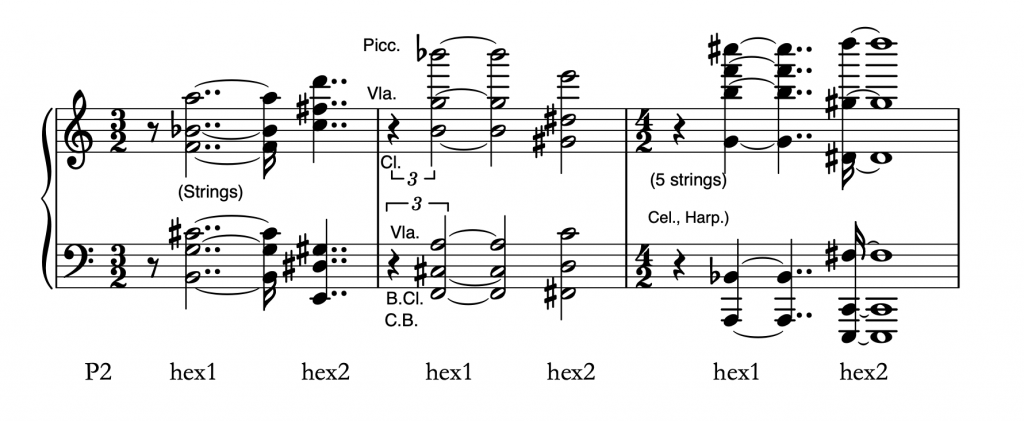
Measure 3 also sees the entrance of the solo cello, poco sforzando, tremolo, and sul ponticello, on a B3 (Example 14). This change in the salient parameter of timbre encourages the retrospective process of grouping together the first three measures and their three constituent cross-partitions into one phrase, whose dominant process of departure and return forms an arch shape. In m. 4, the orchestra drops out as the cello plays the first four notes of its melody: B C A C\sharp
In mm. 9–10, the hexachordal pairs of mm. 1–3 reenter, this time in retrograde and with all three statements compressed into two measures (row form P2). Example 15 presents the three cross-partitions as they appear in the score, while Figure 4 shows the cross-partitions, RD9, RD5, and RDE. I have labeled these according to the final note in the bass since they are retrograde forms of the opening cross-partitions, and thus exactly reproduce the first three measures in retrograde. By placing the three cross-partitions in direct juxtaposition and slurring across hexachords, Dallapiccola draws attention to the melodic features of the three hexachordal pairs as a single unit. This strategy also emphasizes the quasi-cadential effect of hexachordal pair in RDE, which emphasizes leaps by perfect fourth and fifth.
In his analysis of Dialoghi, Dana Richardson refers to the hexachordal pairs in mm. 1–3 and those of mm. 9–10 as “tonal pillars,” which he sees as setting out a “tonic row” (2001, 157). Indeed, the reentrance of this tonic row in the form of three “tonic pillars” after the initial melody played by the solo cello does call to mind a cadential progression signaling the end of a phrase. At this moment, the return to the original timbral, textural, and registral sphere of the opening—as well as the pitch convergence in m. 10—may contribute to our sense of closure when the hexachordal pairs enter. For Hasty in particular, the notion of return is central to structural closure in post-tonal music (Hasty 1981, 1984).14 Importantly, the return of the hexachordal pairs in retrograde validates for the listener a process of departure and return over the course of mm. 1–10, based on the voice leading and timbre of the cross-partitions. Figure 5 compares the six cross-partitions in mm. 1–3 and 9–10. Note how Dallapiccola splits and merges voices to create new voice-leading patterns in the first two cross-partitions of mm. 9–10, but maintains the voice-leading integrity of RDE, the retrograde of the first cross-partition of the piece. The fact that the upper and lower voices remain unchanged from mm. 1–3 to mm. 9–10 encourages the listener to make the connection between these two sections, particularly since these voices are separated in register from the inner voices.
The cello reenters in m. 10 with a new thematic statement (Example 16), retrospectively confirming that the three statements of P2 in mm. 9–10 acted to close a large, arch-shaped theme comprising the three phrases in mm. 1–10 with internal A, B, and A’ sections, akin to what Caplin calls a small ternary form (1998, 71). The cello’s new melody continues the row forms it abandoned in its initial melodic statement of mm. 3–8, picking up at the sixth note of PE. While that melody was highly constrained in terms of its range—circling obsessively first around B3 and then, in the inverted repetition of the first five-note idea, around B4—the theme that enters in m. 10 features a three-note ascending line with the pitch intervals +1, +10. That idea is repeated in a slightly contracted form in the next measure, the dotted quarter notes becoming quarter notes. In m. 11, the cello’s melody sweeps downwards and then upwards again; this melodic idea is condensed rhythmically even further into a quintuplet and brings PE to a close. The cello inverts the preceding melody around F4. This clear inversion of the melody that was just heard, rhythmically identical to the first idea except with each note value shortened slightly, gives the impression of a basic idea being repeated in varied form, creating a presentation in mm. 10–13.

Here is where our close attention to the function and phrase structure of the cross-partitions begins to pay off in our understanding of the phrase more generally in Dialoghi. We can now return to Figure 1, which reveals how mm. 1–10 form a tightly-knit first theme, marked off by the repetition of the three “tonic” pillars—these are marked in orange in Figure 1. The theme is tightly knit by virtue of its symmetrical grouping structures in each of its constituent phrases, its strong cadential closure through the return of the initial cross-partitions in retrograde, and its motivic uniformity, although it is not necessarily a conventional theme according to Caplin’s definition (1998, 84–85). The formal process at work in the entire A section is one of loosening: as the following phrase-level analysis of m. 10 onwards demonstrates, the phrases following the first tightly-knit theme become more loosely-knit and expansive, paving the way for the long, free cello solo of the B section. This process begins with the presentation in mm. 10–13, which suggests the possibility of a continuation.
The impression that mm. 10–13 initiates a sentence phrase is confirmed in mm. 14–16 (Example 17). In m. 14, the cello states an elongated variation on the rising motive in m. 10, in a near-retrograde inversion (+1, +10 becomes +9, +1), using the pitches of RE. The cello is accompanied by a 4×3 cross-partition of R4, first in the brass, and in mm. 15–16 answered by the winds (Figure 6). The percussion instruments also enter en masse at this moment. The cello then begins to alternate between two dyads, {E, D} and {A\sharp
In m. 19, the second two tetrachords of the D2 cross-partition combine with the second trichord of P2 in the solo cello, so that the cello and orchestra align for the first time in order to herald the start of a new section, beginning in m. 21, which brings a new idea and a new way of disguising its row forms (RIT and IT) by distributing the first hexachord of each row across two simultaneous melodic streams in the winds. The first hexachord of IT is inverted in pitch space around the axis of symmetry between F and F\sharp
This new structuring of the salient parameter of pitch materials creates the impression of a new internal section, which begins with a mirrored melody that is immediately repeated. From that repeated idea emerges a series of fragments from row R5, based on the same principle of mirroring. This is followed in m. 26 by a rare and notable moment of homophony in the strings, where Dallapiccola creates a 4×3 cross-partition in which three melodic lines stem from a single pitch, C5 (Figure 8). The initial repetition of a new idea in mm. 21–22 creates a miniature presentation, followed by fragmentation in mm. 23–25 (Example 19). The textural contrast in m. 26, with the homophonic entrance of the 4×3 cross-partition, acts to close this sentential phrase in mm. 21–26.
After the cadential idea of m. 26, the cello enters in m. 27 with melodic fragments based on RI4, pausing before each disjointed two-note fragment before becoming stuck on D\sharp
The preceding analysis reveals that the composer’s compositional scaffolding (i.e. the use of a cross-partitioned twelve-tone row) may interact in productive and provocative ways with the parameters a listener may perceive as salient. The three main salient parameters at work in the first movement of Dallapiccola’s Dialoghi are pitch material, timbre, and register, and the establishment of these parameters as salient from the beginning of the work shapes how we understand the relationships between musical events throughout the movement.
Conclusion
I began with an excerpt from the opening of Webern’s Three Little Pieces Op. 11, No. 1, and I would now like to suggest an interpretation of its opening in terms of phrase structure. Based on perception of salient parameters and categorization of these parameters into distinct units, I suggest that when we hear the first idea return in its altered, expanded form at the end of m. 3, we might retrospectively interpret the first three measures and their three constituent ideas as cohering into one unit, much like the “basic idea” of a presentation phrase (an interpretation diagrammed in Example 20). One might then understand the gesture beginning in the second half of m. 4 in the piano and taken over by the cello as a variation on the second element (y), with the piano and cello combining in order to enrich the original melody of m. 2 (as shown in Example 21). Measure 5 then recalls the cello’s falling gesture in mm. 2–3. In other words, mm. 1–3 present a cohesive basic idea with three elements, each of which is subject to a varied reprise from the end of m. 3 through m. 5—loosely, a repetition of the basic idea—suggesting that mm. 1–5 are a “presentation” phrase. This series of experiences and recollections may then encourage a listener to anticipate elements of a continuational nature to follow.
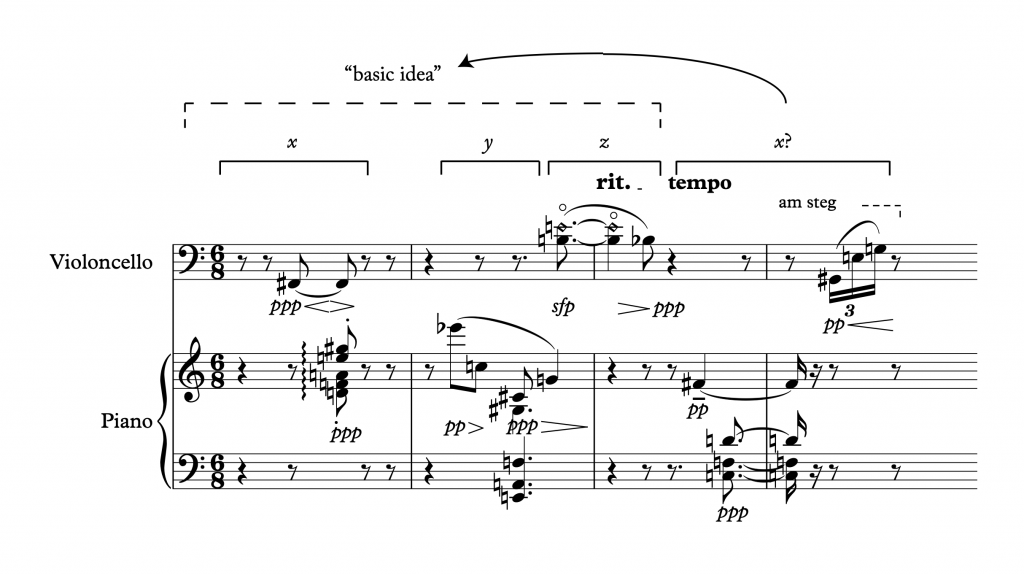
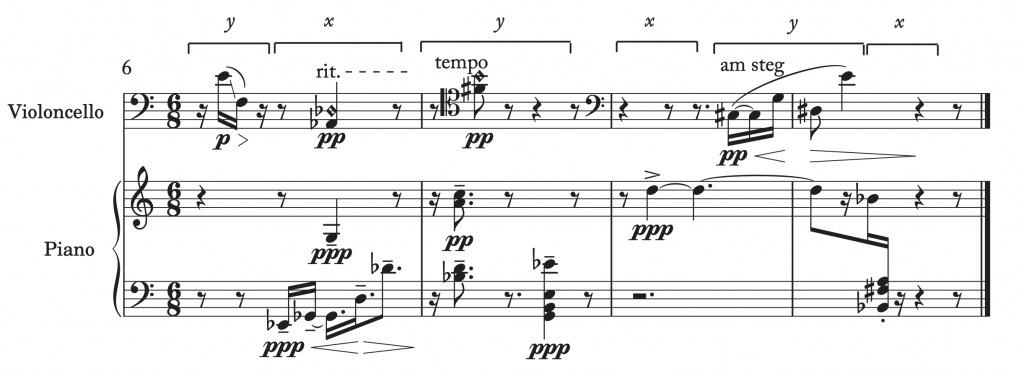
Immediately after the conclusion of the presentation phrase in m. 5, the cello repeats its falling gesture of interval 11, this time played close to the fingerboard and in sixteenth notes, rather than the quarter or eighth notes of previous iterations (Example 22). Next, the piano plays an ascending melody that begins with intervals 3 and 8, which appeared in the opposite order in the cello’s rapid ascending line at the beginning of m. 4. The ascending gesture concludes with an ascending interval 11, mirroring the cello’s descending motive at the beginning of m. 6. The piano’s ascending melody, which is marked ritardando, thus acts as a fragment of the idea that opened both the basic idea and its repetition. Instead of a held note or chord followed by a rapid ascent, the ascent in m. 6 is elongated and occurs simultaneously with the held notes in the cello and the right hand of the piano. After a brief silence, m. 7 similarly elongates the descending gesture that first appeared in the cello in mm. 2–3. Measures 6–7 thus manipulate and fragment in various ways the ideas presented in the work’s first five measures.
After another silence, we hear the sudden onset of a held note in the piano, perhaps referencing the work’s first idea, before the cello enters with a melody, the contour of which features multiple changes in direction—this recalls the piano melody of m. 2. This version of the melody includes several crucial intervals from the movement: the diminished fifth that punctuated the second unit of the first phrase now starts this unit, and an ascending interval 13 (inverting the descending interval 13 that closed the first unit) ends it. Immediately following this melody there is a staccato descending gesture in the piano, with a double-octave between the highest and lowest notes. The descent in the piano completes the mirroring process between the opening three-measure phrase and this last two-measure unit, where each part of the first phrase is performed by the other instrument, the units overlapping to form a summary of preceding events.
The idea that a phrase in a post-tonal composition may possess a changeable function in relation to surrounding musical events asks us to consider a phrase as a topography or constellation of moments, events, or features that have the potential to cohere into a unit, or to disintegrate, separate, fragment, or form connections with other moments or other constellations. The theory of post-tonal phrase presented here urges us to think of phrases as (a) fundamentally relational, since musical events accrue function, and therefore meaning, only in relation to other events and contexts, and (b) constantly mutable, since the listener will reevaluate the meaning of these events in response to how the events unfold over the course of the piece. The elements that make up a post-tonal phrase are porous and admitting of shifts in meaning and function. The manner in which chunks of music relate to each other early in the piece affects not only how phrase formation is perceived throughout, but also the ways in which listeners interpret the changing functions within phrases and of phrases. Through this process, the phrase—being the most immediately accessible and graspable type of musical structure—can become an essential marker for larger-scale formal processes at work. The ways in which pieces teach us to listen to the form-functional relationships that make up phrases will necessarily inform and organize how we hear relationships that are more distant from one another in time. The exploration of listener expectations at the phrase level is a crucial first step in understanding how these relationships are made manifest to listeners. Further work is needed to explore the implications of this theory for larger sections of music, and for music that does not hew as closely to the Western musical traditions of the eighteenth and nineteenth centuries.
Dr. Anabel Maler
She/her
Assistant Professor of Music Theory
The University of Iowa
Chair, SMT Committee on Accessibility and Disability
5415 VOX
319-384-3365
References
Alegant, Brian. 2001. “Cross-Partitions as Harmony and Voice Leading in Twelve-Tone Music.” Music Theory Spectrum 23 (1):1–40. https://doi.org/10.1525/mts.2001.23.1.1
———. 2010. The Twelve-Tone Music of Luigi Dallapiccola. University of Rochester Press.
Arndt, Matthew. 2018. “Form—Function—Content.” Music Theory Spectrum 40 (2): 208–226. https://doi.org/10.1093/mts/mty024
Ashforth, Alden. 1978. “Linear and Textural Aspects of Schoenberg’s Cadences.” Perspectives of New Music 16 (2): 195–224. https://doi.org/10.2307/832684.
Barash, Amari Pepper. 2002. “Cadential Gestures in Post-Tonal Music: The Consititution of Cadences in Messiaen’s ‘Ile de Feu I’ and Boulez’ ‘Premiere Sonate,’ First Movement.” DMA Thesis, The City University of New York.
Bernard, Jonathan W. 1986. “On ‘Density 21.5’: A Response to Nattiez.” Music Analysis 5 (2/3): 207–231. https://doi.org/10.2307/854186.
Boss, Jack, Heather Holmquest, Russell Knight, Inés Thiebaut, and Brent Yorgason, eds. 2016. Form and Process in Music 1300–2014: An Analytic Sampler. Cambridge Scholars Publishing.
Bryden, Kristy Ann. 2001. “Musical Conclusions: Exploring Closural Processes in Five Late Twentieth-Century Chamber Works.” PhD diss., University of Wisconsin-Madison.
Callender, Clifton. 1998. “Voice-Leading Parsimony in the Music of Alexander Scriabin.” Journal of Music Theory 42(2): 219–233.
Cambouropoulos, Emilios. 2009. “How Similar is Similar?” Musicae Scientiae 13 (1_suppl): 7–24. https://doi.org/10.1177/102986490901300102.
Caplin, William E. 1998. Classical Form: A Theory of Formal Functions for the Instrumental Music of Haydn, Mozart, and Beethoven. Oxford University Press.
———. 2005. “On the Relation of Musical Topoi to Formal Function.” Eighteenth Century Music 2 (1): 113–124. https://doi.org/10.1017/S1478570605000278.
———. 2009. “What Are Formal Functions?” In Musical Form, Forms & Formenlehre: Three Methodological Reflections, edited by William Earl Caplin, James A. Hepokoski, James Webster, and Pieter Bergé. Leuven: Leuven University Press.
———. 2018. “Beyond the Classical Cadence: Thematic Closure in Early Romantic Music.” Music Theory Spectrum 40 (1): 1–26. https://doi.org/10.1093/mts/mty002.
Caplin, William Earl, James A. Hepokoski, James Webster, and Pieter Bergé. 2009. Musical Form, Forms & Formenlehre: Three Methodological Reflections. Leuven University Press.
Cuddy, Lola L., and Carole A. Lunney. 1995. “Expectancies Generated by Melodic Intervals: Perceptual Judgments of Melodic Continuity.” Perception & Psychophysics 57 (4): 451–462. https://doi.org/10.3758/BF03213071.
Deliège, Irène. 1989. “A Perceptual Approach to Contemporary Musical Forms.” Contemporary Music Review 4 (1): 213–230. https://doi.org/10.1080/07494468900640301.
———. 2007. “Similarity Relations in Listening to Music: How Do They Come into Play?” Musicae Scientiae 11 (1_suppl): 9–37. https://doi.org/10.1177/1029864907011001021.
Derfler, Brandon. 2010. Single-Voice Transformations: A Model for Parsimonious Voice Leading. Newcastle upon Tyne: Cambridge Scholars Publishing.
Eng, Sher Ling Clare. 2012. “Motif and Closure in Twentieth Century Music: Bartók, Britten and Fauré.” PhD diss., Yale University.
Fennelly, Brian. 1966. “Structure and Process in Webern’s Opus 22.” Journal of Music Theory 10 (2): 300–328. https://doi.org/10.2307/843246.
Gell, Alfred. 2013. “The Network of Standard Stoppages.” In Distributed Objects: Meaning and Mattering after Alfred Gell, edited by Liana Chua and Mark Elliott, 246–313. Berghahn Books.
Hanninen, Dora A. 2012. A Theory of Music Analysis : On Segmentation and Associative Organization. University of Rochester Press.
Harrison, Daniel. 2016. Pieces of Tradition: An Analysis of Contemporary Tonal Music. Oxford University Press.
Hasty, Christopher. 1981. “Segmentation and Process in Post-Tonal Music.” Music Theory Spectrum 3 :54–73. https://doi.org/10.2307/746134.
———. 1984. “Phrase Formation in Post-Tonal Music.” Journal of Music Theory 28 (2): 167–190. https://doi.org/10.2307/843531.
———. 1988. “Composition and Context in Twelve-Tone Music of Anton Webern.” Music Analysis 7 (3): 281–312. https://doi.org/10.2307/854084.
Heneghan, Áine. 2019. “Liquidation and Its Origins.” Journal of Music Theory 63 (1): 71–102. https://doi.org/10.1215/00222909-7320474.
Howland, Patricia. 2010. “Formal Processes in Post-Tonal Music: A Study of Selected Works by Babbitt, Stockhausen, and Carter.” PhD diss., The City University of New York.
———. 2015. “Formal Structures in Post-Tonal Music.” Music Theory Spectrum 37 (1): 71–97. https://doi.org/10.1093/mts/mtv011.
Huron, David. 2006. Sweet Anticipation: Music and the Psychology of Expectation. MIT Press.
Krumhansl, Carol L. 1995. “Effects of Musical Context on Similarity and Expectancy.” Systematische Musikwissenschaft 3 (2): 211–250.
Lamont, Alexandra, and Nicola Dibben. 2001. “Motivic Structure and the Perception of Similarity.” Music Perception: An Interdisciplinary Journal 18 (3): 245–274. https://doi.org/10.1525/mp.2001.18.3.245.
Levine, Caroline. 2015. Forms: Whole, Rhythm, Hierarchy, Network. Princeton University Press.
Maler, Anabel. 2018. “Hearing Form in Post-Tonal Music.”PhD diss., The University of Chicago.
Maler, Anabel. 2020. Unpublished manuscript.
Margulis, Elizabeth Hellmuth. 2012. “Musical Repetition Detection Across Multiple Exposures.” Music Perception: An Interdisciplinary Journal 29 (4) :377–385. https://doi.org/10.1525/mp.2012.29.4.377.
———. 2014. On Repeat: How Music Plays the Mind. Oxford University Press. https://doi.org/10.1093/acprof:oso/9780199990825.001.0001.
Meyer, Leonard B. 1956. Emotion and Meaning in Music. The University of Chicago Press.
———. 1957. “Meaning in Music and Information Theory.” Journal of Aesthetics and Art Criticism 15 (4): 412–424. https://doi.org/10.2307/427154.
Nattiez, Jean-Jacques, and Anna Barry. 1982. “Varese’s ‘Density 21.5’: A Study in Semiological Analysis.” Music Analysis 1 (3): 243–340. https://doi.org/10.2307/854178.
Norman, Donald A. 2013. The Design of Everyday Things, Revised and Expanded Edition. Basic Books.
O’Donnell, Shaugn. 1997. “Transformational Voice Leading in Atonal Music.” Ph. D. dissertation, City University of New York.
Perle, George. 1990. The Listening Composer, Ernest Bloch Lectures. University of California Press.
Ratz, Erwin. 1951. Einführung in die Musikalische Formenlehre; Über Formprinzipen in den Inventionen J.S. Bachs und ihre Bedeutung für die Kompositionstechnik Beethovens. Vienna: Österreichischer Bundesverlag für Unterricht, Wissenschaft und Kunst.
Richards, Mark. 2010. “Closure in Classical Themes: The Role of Melody and Texture in Cadences, Closural Function, and the Separated Cadence.” Intersections 31 (1): 25–45.
Richardson, Dana. 2001. “Dallapiccola’s Formal Architecture.” PhD diss., New York University.
Rothstein, William. 1990. Phrase Rhythm in Tonal Music. Schirmer.
Schellenberg, E. Glenn. 1996. “Expectancy in Melody: Tests of the Implication‐Realisation Model.” Cognition 58 (1): 75–125. https://doi.org/10.1016/0010-0277(95)00665-6.
Schmalfeldt, Janet. 2011. In the Process of Becoming: Analytic and Philosophical Perspectives on Form. Oxford University Press.
Schmuckler, Mark A. 1989. “Expectation in Music: Investigation of Melodic and Harmonic Processes.” Music Perception 7 (2): 109–149. https://doi.org/10.2307/40285454.
Schoenberg, Arnold. 1967. Fundamentals of Music Composition. Faber and Faber.
Tenney, James. 1988. Meta-Hodos and Meta Meta-Hodos: A Phenomenology of 20th Century Musical Materials and an Approach to the Study of Form. Frog Peak Music.
Webern, Anton. 1975. The Path to the New Music. Translated by Leo Black. Universal Edition.
Zbikowski, Lawrence M. 2002. Conceptualizing Music: Cognitive Structure, Theory, and Analysis. Oxford University Press.
Notes
- Some relevant contributions to the literature on formal function and post-tonal form include Arndt (2018), Boss et al. (2016), Caplin (1998), Caplin et al. (2009), Caplin (2018), Deliège (1989), Hasty (1981, 1984), Howland (2010, 2015), Richards (2010), Schmalfeldt (2011), Tenney (1988).
- See Heneghan (2019) for a detailed discussion of Schoenberg’s concept of liquidation.
- Following Paul Hindemith’s and Ernst Krenek’s classification of chords on a scale of more-or-less dissonant, Daniel Harrison proceeds from a similar understanding of “resolution” involving a “more-to-less” chord change (Harrison 2016, 4). Bryden (2001) explores a similar definition of closure in terms of lines of increasing and decreasing intensity in five chamber works.
- Other recent students that have engaged with the concepts of repetition include Emilios Cambouropoulos’s study of similarity, which emphasizes the importance of context (2009), Irène Deliège’s work on similarity relations in listening experience (2007), and Elizabeth Margulis’s work on musical repetition (2012, 2014).
- I take this helpful summary from Alfred Gell’s essay, “The Network of Standard Stoppages,” originally written circa 1985 (Gell 2013, 102–107).
- The subject of expectation also forms the basis of David Huron’s “ITPRA” (Imagination-Tension-Prediction-Reaction-Appraisal) theory of expectation (Huron 2006, 16). Huron’s work reveals how common musical devices make use of these basic psychological responses, arguing that expectation “appears to shape many aspects of musical organization,” including patterns of repetition and form, motivic structure, and genre and style (357).
- The neutral level is defined by Nattiez as “a descriptive level containing the most exhaustive inventory possible of all types of configurations conceivably recognizable in a score,” the poietic level deals with the “process of production by which the work unfolds,” and the esthesic level with the “processes of perception” to which the work gives rise (Nattiez and Barry 1982, 244–245).
- As Bernard (1986) states, “Nattiez is not entitled to speak of any kind of operative deception in Varèse’s music, which is not part of a common practice with expected norms” (223).
- All recompositions are the author’s.
- George Perle (1990) notes that the first five measures of the piece outline the C\sharpto G tritone, which is in turn divided by E\natural. Perle argues that this division exists from the work’s opening, in which the first note, F, is nothing more than an upper neighbor to the structural note E; this C\sharp-E-G diminished triad is confirmed in m. 5, and subsequently expanded to a fully diminished seventh chord with the addition of B\flatin m. 6. While my own interpretation does not view the initial F as incidental, I agree that the introduction of IC3, bridging the gap between motive a and the tritone of motive c in m. 5, is crucial.
- Where 0 = C.
- It is also worth noting that the hexachords of the row in Dialoghi are near whole-tone collections, misplacing a single pitch class. The nature of these collections informs the compositional decisions Dallapiccola makes.
- Ways of modeling these “split/fuse” operations in parsimonious voice-leading have been discussed at length by Shaugn O’Donnell (1997), Clifton Callender in the context of Scriabin’s music (1998), and Brandon Derfler (2010). The splitting and fusing here is emphasized by the voicings in the strings at this moment in the score. In identifying split/fuse relationships, I have preserved Dallapiccola’s original voicings in the score, which emphasize these voice-leading relationships.
- There have been several attempts to define cadential content in post-tonal repertoires in recent years, including the work of Hasty (1981, 1984), Ashforth (1978), Barash (2002), Eng (2012), Maler (2018). These authors identify motivic dissolution, repetition, pitch convergence or divergence, registral aspects, textural elements including density and contrast, rhythm, timbre, orchestration processes involving tension and abatement, and phrase structure as important elements that contribute to defining post-tonal cadential closure.
